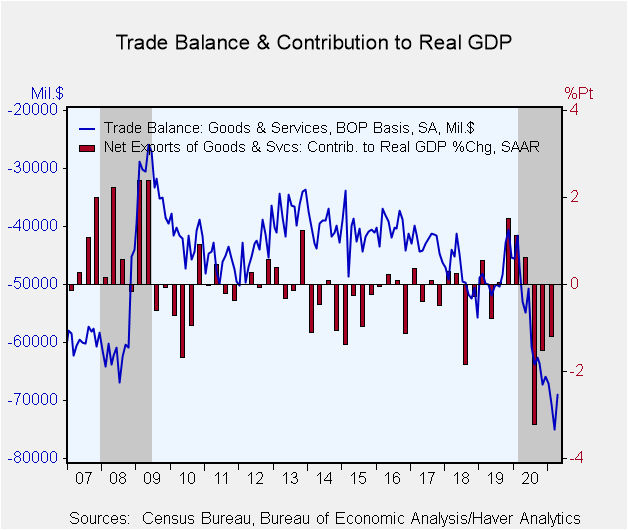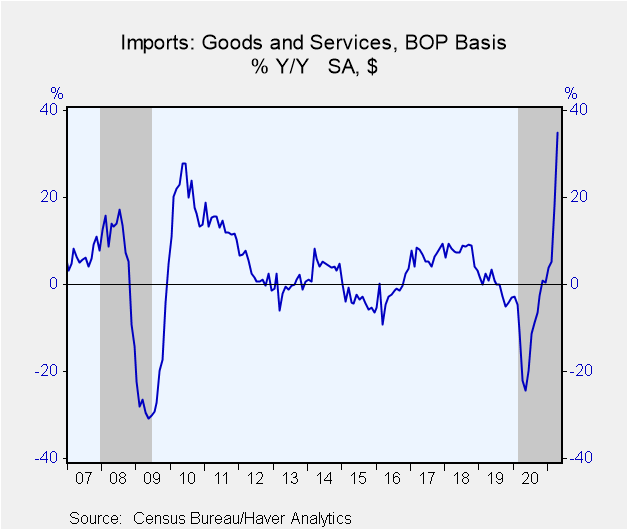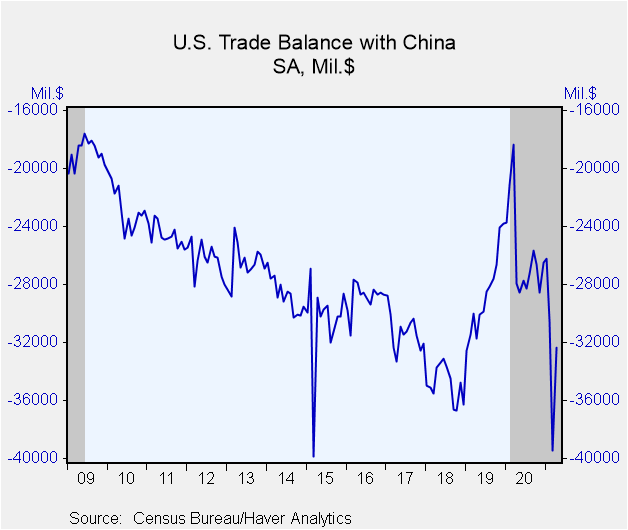 Global| Jun 08 2021
Global| Jun 08 2021U.S. Trade Deficit Narrowed in April
by:Sandy Batten
|in:Economy in Brief
Summary
• Exports rose while imports fell. • Service surplus narrowed further. • Narrowing real deficit points to trade contributing to Q2 GDP growth. The U.S. trade deficit in goods and services narrowed to $68.90 billion in April from a [...]
• Exports rose while imports fell.
• Service surplus narrowed further.
• Narrowing real deficit points to trade contributing to Q2 GDP growth.
The U.S. trade deficit in goods and services narrowed to $68.90 billion in April from a revised $75.03 billion in March (originally $74.45 billion), which was a record for this series dating back to January 1992. The Action Economics Forecast Survey anticipated a $69.0 billion deficit.
Today's report contained revisions back to the beginning of 2013. According to the Census Bureau, "This annual revision has not changed the overall trend in the goods and services balance. The annual goods and services deficit was revised by 0.2% or less (positive or negative) for 2013–2019. For 2020, the deficit was revised down 0.7%, reflecting a 4.9% upward revision to the services surplus. That was partly offset by the 0.7% upward revision to the goods deficit."
Exports increased 1.1% m/m (36.6% y/y) in April on top of a 7.5% monthly jump in March. By contrast, imports fell 1.4% m/m (+34.9% y/y) in April after a 7.1% rise in March. Both petroleum and nonpetroleum imports fell in April.
The trade deficit in goods narrowed to $86.7 billion in April from a record $92.9 billion in March. Today's figure was slightly larger than the $85.2 billion deficit reported in the advance report released on May 28. Exports of goods increased 1.1% m/m (+52.5% y/y) in April, led by a 4.9% monthly gain in exports of capital goods excluding autos. Exports of industrial supplies rose 1.6% m/m. Auto exports fell 7.9% m/m and nonfood consumer goods exports slipped 1.5% m/m in April after having surged 13.5% m/m in March.
Petroleum imports fell 1.3% m/m (+151.3% y/y) in April, their first monthly decline in eleven months. Nonpetroleum imports fell 2.0% m/m (+32.5% y/y), their second decline in the past three months following eight consecutive monthly increases.
The real (adjusted for price changes) trade deficit narrowed to $98.6 billion (chained 2012 dollars) in April from a record $105.8 billion in March. Net exports in the national accounts subtracted 1.2%-points from overall real GDP growth in Q1. The narrowing of the real deficit in April puts net exports on course to be a contributor to GDP growth in Q2 for the first time since Q2 2020.
The March services trade surplus narrowed slightly for the third consecutive month to $17.78 billion in April from an upwardly revised $17.83 billion in March. The April figure was the smallest surplus since August 2012. The value of services exports rose 1.2% (+8.5% y/y), led by a 4.6% monthly increase in travel and a 4.3% m/m gain in transport exports. Service imports rose 1.8% m/m (+25.5% y/y) in April with widespread gains led by a 9.1% m/m jump in travel.
The goods trade deficit with China narrowed to a seasonally adjusted $32.4 billion in April from $39.4 billion in March. Exports rose 8.7% m/m while imports slumped 11.7% m/m. The trade deficit with Japan widened to $5.4 billion, but the deficit with the European Union narrowed to $16.1 billion.
The international trade data, including relevant data on oil prices, can be found in Haver's USECON database. Detailed figures on international trade are available in the USINT database. The expectations figures are from the Action Economics Forecast Survey in AS1REPNA.
| Foreign Trade in Goods & Services (Current $) | Apr | Mar | Feb | Apr '20 | 2020 | 2019 | 2018 |
|---|---|---|---|---|---|---|---|
| U.S. Trade Deficit ($ bil.) | 68.90 | 75.03 | 70.64 | 52.96 | 676.69 | 576.34 | 580.95 |
| Y/Y% | |||||||
| Exports of Goods & Services (% Chg) | 1.1 | 7.5 | -2.4 | 36.6 | -15.6 | -0.4 | 6.2 |
| Imports of Goods & Services (% Chg) | -1.4 | 7.1 | -0.4 | 34.9 | -9.5 | -0.5 | 7.4 |
| Petroleum (% Chg) | -1.3 | 17.4 | 9.8 | 151.3 | -39.7 | -14.0 | 20.8 |
| Nonpetroleum Goods (% Chg) | -2.0 | 7.1 | -1.3 | 32.5 | -3.5 | -0.5 | 7.3 |
Sandy Batten
AuthorMore in Author Profile »Sandy Batten has more than 30 years of experience analyzing industrial economies and financial markets and a wide range of experience across the financial services sector, government, and academia. Before joining Haver Analytics, Sandy was a Vice President and Senior Economist at Citibank; Senior Credit Market Analyst at CDC Investment Management, Managing Director at Bear Stearns, and Executive Director at JPMorgan. In 2008, Sandy was named the most accurate US forecaster by the National Association for Business Economics. He is a member of the New York Forecasters Club, NABE, and the American Economic Association. Prior to his time in the financial services sector, Sandy was a Research Officer at the Federal Reserve Bank of St. Louis, Senior Staff Economist on the President’s Council of Economic Advisors, Deputy Assistant Secretary for Economic Policy at the US Treasury, and Economist at the International Monetary Fund. Sandy has taught economics at St. Louis University, Denison University, and Muskingun College. He has published numerous peer-reviewed articles in a wide range of academic publications. He has a B.A. in economics from the University of Richmond and a M.A. and Ph.D. in economics from The Ohio State University.










